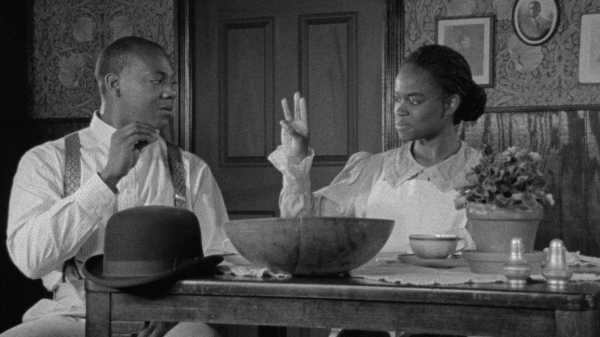
Save this storySave this storySave this storySave this story
It took only twenty-five years from the time that “Compensation,” Zeinabu irene Davis’s first fiction feature, premièred at Sundance to the time, this coming Friday, that it gets its theatrical release. Many films have languished in undue obscurity because of obtuse reviews when they were first screened. “Compensation,” however, received several enthusiastic ones out of Sundance (including from Roger Ebert, in the Chicago Sun-Times), yet a review in Variety, as if hooked on Hollywood varnish, damned it as “imaginatively conceived but indifferently executed” and condemned it to the “noncommercial” realm. It was a bad time for the releasing of independent and international films in general, and “Compensation” was among the best films to remain in the shadows until it resurfaced, a decade ago, at special screenings, for a more receptive generation of viewers and industry people alike.
I first saw it in 2017, when it screened at MOMA; first reviewed it in 2019, when it played at BAM; and have been writing about it every chance that I get, because it’s a many-faceted film that, in the span of a mere hour and a half, keeps revealing wonders. Like most great movies, “Compensation” expands the possibilities of the cinema, and my belated viewing of it offered the uncanny feeling of a vicarious memory—of an experience that I’d never had but that instantly felt like a part of my own past, a missing one that had just been filled in. Now, rewatching the movie, in a new digital restoration (or, as Davis calls it, a “rejuvenation”), I latched on to aspects of it that, though always plainly present, now strike me as decisive: its framework, its form. However elaborate a work of art may be, the essence of genius is simplicity, and with “Compensation” Davis turns the inherent difficulties of a low-budget production into a spare and clear form, which proves to be more capacious than that of most high-budget spectacles. That form inflects the entire movie—the contours of its dramas, the style of the performances, the earnest emotionalism—while also embodying a noteworthy conceptual vision. The result is as intimate as it is abstract, as analytical as it is lyrical; Davis fuses a style of graceful candor with an ideal of historical scope.
“Compensation” presents two parallel, intercut stories that are linked dramatically and thematically, and which, between them, frame the twentieth century. One is set around 1993 (when the filming began), and the other is set in and just after 1906. Both tales are set in Chicago, in the Black community, and both involve a romantic relationship between a deaf woman and a hearing man. In the historical one, Malindy Brown (Michelle A. Banks), an intellectual and an activist who works as a seamstress, meets a laborer named Arthur Jones (John Earl Jelks); the modern one presents the relationship of Malaika Brown (also played by Banks), a printer and an aspiring graphic artist, and Nico Jones (Jelks), a children’s librarian. In both stories, the very possibility of a relationship depends on the man learning American Sign Language. (Malindy teaches Arthur while also teaching him to read and write; Nico learns A.S.L. by attending classes.) In both, the relationship is viewed skeptically by the woman’s circle: Malindy’s mother questions her bond with an uneducated man; a friend of Malaika’s challenges her connection with a hearing person. In both, Black culture plays a prominent role, starting with a poem by Paul Laurence Dunbar from which the film gets its title. And, in both, epidemic diseases get in the way. (It’s no spoiler to note that Dunbar’s poem, which is displayed onscreen in a title card before the action begins, ends with the word “death.”)
The stories and the themes of “Compensation” come to life through a set of extraordinary devices whose aptness, as with all great discoveries, seems logically inevitable once it’s been done. Because movies of the nineteen-aughts were silent, Davis tells the story of Malindy and Arthur as a silent film, complete with intertitles for dialogue and narration. Yet she signals the idiosyncrasy of this choice by adding a soundtrack that, while it lacks speech, includes some sound effects, as if to call attention to the crucial absence of spoken dialogue. (There’s also copious piano music, much of it ragtime, composed and played by Reginald R. Robinson—evoking accompaniments to movie screening in the silent era.) The silent movie is also a reconstitution of a long-ago world, and it’s as precise as it is expressive: Davis relies on evocative outdoor locations (parks, beaches, old houses) to depict the public realm. For indoor settings, such as the neat, comfortable room where Malindy lives, Davis’s production design is modest and expressive. Moderately ornamented furniture, white cloths and lace curtains, lively wallpaper above plain wainscoting, and a spare but formal array of glassware conjure the era in eye-catching touches—as do Malindy’s flowing clothing, straw hat, and velvet finery, and Arthur’s suspenders, high-waisted pants, tab collars, and bowler hat. Davis’s straightforward yet cannily composed images (thanks to cinematography by Pierre H. L. Désir) feel recovered from the past; in their concentrated poise, they let material details sing.
Davis’s prime device for depicting the past and for bringing Malindy and Arthur’s world to life depends on a wealth of archival photographs, and it is one that risks being misunderstood if not clearly named: “Compensation” is, in part, a documentary. Throughout, Davis weaves into the action a personally curated archive, rendered vital and immediate by her cinematic treatment. The camera moves across the photographs in a way that creates a sort of montage: zooming in on details, expanding outward to reveal panoramic views, and bringing real-life people into closeups so joltingly expressive that they seem like actors in the drama. The movie opens with such a documentary sequence, a history lesson of the Great Migration: photographs establish the doubling of Chicago’s Black population from 1900 to 1910 and some landmarks of culture that went with it, such as the publication of W. E. B. Du Bois’s “The Souls of Black Folk” and of Scott Joplin’s opera “Treemonisha.” None of the movie’s dramatic characters are introduced until this elaborate first sequence runs its course.
The mass movement of the Great Migration is seen in archival images of train trips through rural fields where Black people do farm work and in pictures of the turmoil and energy of the industrial city. In the ideal of “education, employment, enlightenment” offered by city life, Davis shows urban Black businesspeople and artisans at their trades. When Malindy is introduced, Davis supplies a photograph of an integrated school for the deaf from the late nineteenth century, such as the one Malindy attended, in Mississippi. (Her school becoming segregated, in 1906, is what made her move to Chicago.) Introducing Arthur’s work as a meatcutter in the meatpacking plants abutting Chicago’s stockyards, Davis supplies historical images of the stockyards that vividly conjure the hard and dangerous work, seemingly even the stench. What emerges in these nonfiction segments isn’t the quantity of the research but its intensity—a sense of discovery in the archives to equal the sense of discovery that emerges from the on-set performances, which have the thrill of immediate creation.
There’s just as much documentary woven into the overtly fictional sequences—for starters, the documentation of cultural history. Malindy’s story involves the poems of Dunbar, the magazine The Crisis (founded by Du Bois and published by the N.A.A.C.P.), the journalistic activism of Ida B. Wells (to whom Malindy writes about the segregation of her school), the Black opera singer Sissieretta Jones, and, especially, Black cinema: movies made by Black artists for Black viewers. Davis homes in on a real-life example of this form, a short comedy called “The Railroad Porter,” which is now lost, and recreates it, in a scene where Malindy, Arthur, and their friends go to the movies. (Emblematically, this is the one scene in the 1906 story to feature spoken dialogue—the audience talking back to the screen!)
In the modern story, Malaika, an artist, also dances (Banks is a choreographer and a dancer), and Dunbar’s poetry figures repeatedly in her story and Nico’s, too; the poem of the title, set to music, inspires a remarkable dance performance by Malaika’s friend Bill (Christopher Smith). Malaika and Nico are both ardently involved with African art and music and take part in Yoruba rituals. (The score in the modern section, used sparingly and strikingly, featuring percussion-based compositions and instruments, is by Atiba Y. Jali.) Pop culture of the time also plays a role, as Malaika and Nico face a comical conundrum when trying to pick a movie at a local multiplex.
There’s yet another documentary element at the center of “Compensation”: deafness. The lives of the movie’s two deaf women, and their relationships in the speaking world, are shown with a forthright engagement. For Davis, deafness isn’t a metaphor, it’s simply a way of life and a realm of experience. (The restored version of the film, thanks to new technology, includes far more onscreen captions for the hearing-impaired.) Indeed, the script, by Marc Arthur Chéry, who is also Davis’s husband, didn’t originally center on deaf characters, but when the couple saw a stage performance by Banks—who had founded a theatre company for deaf Black actors—Davis instantly decided to cast her, and changed the characters and the script accordingly. Both stories emphasize the centrality of A.S.L., its accessibility to hearing people as a second language, and—particularly in the modern story—a view of deaf culture as a vital aspect of culture at large. In the modern story, deaf culture is far more widely developed. The resulting paradox is that, as deaf culture expands (but hearing people’s knowledge of it hardly keeps up), relationships between deaf people and hearing people become increasingly fraught and difficult.
The distinctive form of “Compensation” has an inherently didactic aspect. In telling the cognate tales of Malindy and Malaika, Davis builds a mighty arc of time—a view of intimate life as inextricable from the great forces of history, of romance as inseparable from cultural creation, of the present day tethered as tightly to the past, as if the connection were telepathic, metaphysical. Even the performances have an exemplary historical tenor. Banks and Jelks, as directed by Davis, offer a combination of fluid expression and solid reserve, of monumentality in intimacy, that has more in common with the ways of classic Hollywood stars than with pliable modern actors of realistic bent. Although both actors distinguish their historical and modern characters by way of different tones of performance and different gesture repertories, the continuities are far more evident than the differences, which is, in large part, the energizing idea of “Compensation.”
The great power of the movie, beyond the passionate specifics of its romantic dramas, is in the distillation of an enormous vision of historical unity. From country to city, culture at large into private life, the domestic sphere into the public realm, the religious world to the secular one, the deaf to the hearing, from Africa to America, from writer to reader and artist to viewer, Davis displays the relentless flow of communication, the transmission of experiences and ideas from person to person and from generation to generation. “Compensation” has the rare virtue of both depicting and embodying the personal experience of history’s continual process of rediscovery and reclamation. Plenty of movies, particularly independent ones, fall into the zone of oblivion at the time of their creation. Occasionally, one of them may be recognized belatedly as a masterwork that retroactively transforms the history of cinema and guides its future. “Compensation” is one of the few such films to exemplify its own destiny. ♦
Sourse: newyorker.com







